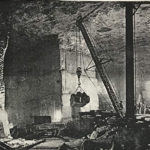By Tyler Reach
June 13, 1963
A supply of survival rations and water containers was delivered here yesterday and deposited in the mammoth Imperial Marble Quarry.
The unusual cargo, which will eventually include sanitation and medical kits, will permit the Vermont Marble Company’s huge quarry to be turned into a two-week fallout shelter for 7,000 persons in case of nuclear attack.
Trucked in from the Schenectady Army Depot, the 35,032 pounds of survival “crackers” and 1,400 7 1/2-pound metal water containers were slowly lowered into the vast underground cavern by the same winch and crane that usually lifts out multi-ton blocks of marble.
The Imperial Marble Quarry is one of several large buildings and underground facilities in Vermont designated as official fallout shelter. According to Roy Webster of Danby, quarry superintendent, the cavern would provide 100 percent protection from fallout. With only one entrance, the 72 million cubic foot area is covered by 200 to 275 feet of marble, rock and earth.
Theoretically, the Danby Quarry could hold as many as 5,000 persons, and that was the original estimate of engineers. But as a practical matter, much of that space would be uninhabitable. As marble has been removed over the years, much of the space has been refilled with marble pieces or tailings.
During a fallout emergency, ventilation and electric lights would be provided in the cavern by means of an auxiliary power supply. This power would also continue pumping out the water that flows into the quarry from underground springs.
There would be no heat problem. Temperature in the quarry remains a constant 47 degrees summer and winter. Webster knows the temperature because he checked it for a long period of time for a firm interested in growing mushrooms in unused sections of the quarry. It turned out that 47 degrees was a crucial three degrees too cold for that kind of commercial operation.
The unchanging temperature, plus periodic maintenance of the cavern roof, accounts for the fact that a piece of marble has never fallen from the ceiling since quarrying began here in 1906, Webster says. He explains that the absence of expansion and contraction of the rock due to temperature changes means that there are no natural forces to shake the rock loose.
What would happen if more than 7,000 persons appears at the quarry in the event of attack? “We’d lock the doors,” Webster says, because there would be neither food nor practical space for any more. Despite the vastness of the quarry, it is the square footage of available space that determines its capacity for human occupancy, not its cubic feet, he explains.
If the fallout shelter program becomes a national institution it wouldn’t be the first one to be supported by the Imperial Marble Quarry of Danby. From these depths have come the marble blocks that now form the U.S. Supreme Court building in Washington, as well as the Jefferson Memorial, the U.S. Senate Office Building, and the Oregon Capitol.
The largest single stone ever taken from the quarry weighed 83 tons. It was used to form the decorative eagle, carved in relief on the Veterans Memorial Building in Detroit, Mich.
One of the foreseeable problems in case of attack would be that of parking the estimate 1,200 to 1,500 cars that would bring 7,000 persons to the quarry. There is little enough parking for the 150 employees who work in two daily shifts there.
Motorists driving along U.S. 7 in Danby only see the bottom of the quarry’s funicular railroad.

